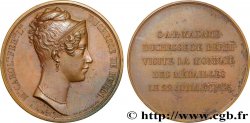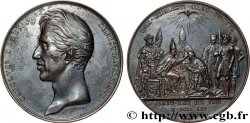fme_943345 - CHARLES X Médaille, Mathieu Jean Félicité, duc de Montmorency-Laval
75.00 €(Approx. 77.25$ | 63.00£)
Quantity
Add to your cart

Type : Médaille, Mathieu Jean Félicité, duc de Montmorency-Laval
Date: 1826
Metal : bronze
Diameter : 50,5 mm
Orientation dies : 12 h.
Engraver BARRE Jean-Jacques (1793-1855)
Weight : 39,46 g.
Edge : lisse
Puncheon : sans poinçon
Coments on the condition:
Patine marron hétérogène avec des taches d’oxydation. Petite usure. Traces de manipulation dans les champs
Obverse
Obverse legend : M. J. F. DUC MATHIEU - DE MONTMORENCY..
Obverse description : Tête de profil à gauche, signé : BARRE F.T.
Reverse
Reverse legend : PAIR DE FRANCE MINISTRE D’ETAT GOUVERNEUR DU DUC DE BORDEAUX // FIDELE / A SON DIEU / AIME DE SON ROI / RESPECTE DES GRANDS / BIENFAITEUR DES PAUVRES / UNE SAINTE MORT / TERMINA / SON ILLUSTRE CARRIERE / A L’AGE DE 59 ANS / LE 24 MARS / 1826.
Reverse description : Légende circulaire et en 11 lignes.
Commentary
Mathieu Jean Félicité, duc de Montmorency-Laval (1766-1826) est un militaire et homme politique français révolutionnaire, admirateur des Philosophes, ensuite rallié à la Restauration des Bourbons.








 Report a mistake
Report a mistake Print the page
Print the page Share my selection
Share my selection Ask a question
Ask a question Consign / sell
Consign / sell
 Full data
Full data









